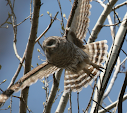
Everyone has to start somewhere, and I chose to begin identifying and listing the birds I saw accurately in October 2008.
Specifically I went for my first birdwatching/photographing hike on October 20th 2008.
What I had missed in my late start I attempted to make up for in lost time. I took two trips out of state in that period, visited 2 National Parks and two National Wildlife Refuges, and as a final treat participated in two Christmas Bird Counts for my 2008 birding year.
My result was 80 species.
Not too bad for a beginner who quickly realised that pinning down a species identification is much more difficult than he would have initially believed.

The highlights:
Discovering Northern Flickers in plain sight. I had seen these occasionally as a child, but never noticed them in Colorado. I caught a glimpse of a bird after dusk in a large field with my bins, and was focusing in to try to get an ID in the growing darkness. Just then it burst into flight and his red coloring exploded into view through my bins. Even though I have found this guy to be a regular and now have his picture by the hundreds he is a favorite. He reminds me about how much is out there unseen, when we don't take the time to look.
Maxwell National Wildlife Refuge. My first dedicated birding trip, and such a rewarding one. For an entire day I had the refuge to myself. Until that trip I had been catching myself up. I was listing species that I had often seen before. On that trip I saw and was able to identify species that were completely new to my list, and solve the great Sandhill Crane mystery.
Rocky Mountain National Park. A solo hike to Ouzel Falls on an unseasonably warm early December morning. In addition to having the place almost to myself I had great views of a Lesser Goldfinch and a Steller's Jay.
Rock Mountain Arsenal National Wildlife Refuge. I volunteer here a bit, but on a frosty December morning I went to do a bit of birding. The cold kept everyone else away. I was treated to the rising of thousands of Canadian Geese before I had even left the parking lot, Bald and Golden Eagles perched and in flight, a Sharp-Shinned Hawk directly overhead, and a handful of new species.
Two great Christmas Bird Counts, of which I may post more at a later date. The Boulder CBC was cold and snowy. I met some great people hiking in the foothills above town, and our highlight was a Brown Thrasher, seen on only a handful of previous Boulder CBCs. The Denver CBC was a week later. My group worked the South Platte section and I had a marvelous day tagging along as the experts in my group helped me identify 49 species in a single day.
Finally, I had two great walks in Minnesota around the lake near my parents home. It was great to return to the parks of my childhood. My first walk was in single-digit temps hovering on either side of zero after a fresh coating of snow. I didn't see any new species, but got good comparison pictures of an Eastern Song Sparrow.
On my second venture I had beautiful blue skies, and mild temps (teens and 20s are mild for MN in December). I was watching Chickadees, Nuthatches, a Cardinal and some squirrels interact around a feeder when a bird flew overhead with a strange call. I recognised her flight for a woodpecker or flicker, neither of which I had in Minnesota. I followed her across the parking lot and started snapping off long range photos. At the time I thought I had a Flicker or a Hairy, either one a new state bird. I was hoping she may be a different plumaged Flicker, and as I started working through my picks the red on her nape threw me. Not right for a Flicker, and yet not a Hairy either. I dug the Sibley guide out of my camera bag and started flipping through Woodpeckers. There she was, completely unexpected, never before seen by these eyes, a Red-Bellied Woodpecker.

Here's to a bigger and better 2009:
May there be more species, surprises, and may all your birds be well seen!


